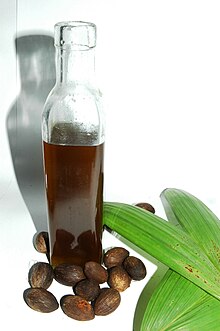Oenocarpus bataua
| Oenocarpus bataua | |
|---|---|

| |
| Scientific classification | |
| Kingdom: | Plantae |
| Clade: | Tracheophytes |
| Clade: | Angiosperms |
| Clade: | Monocots |
| Clade: | Commelinids |
| Order: | Arecales |
| Family: | Arecaceae |
| Genus: | Oenocarpus |
| Species: | O. bataua
|
| Binomial name | |
| Oenocarpus bataua | |
| Synonyms[2] | |
| |
Oenocarpus bataua, the patawa, sehe, hungurahua (Ecuador) or mingucha, is a palm tree native to the Amazon rainforest. The tree produces edible fruits rich in high-quality oil.[3]
Distribution and habitat
[edit]It is native to the tropical rainforests of South America and is abundant in the wet zones at elevations less than 1,000 m (3,300 ft). Its distribution stretches from Panamá and Trinidad to the Amazon basin (Colombia, Venezuela, Guianas, Brazil, Bolivia, Ecuador, Peru).[2] Two varieties are recognized:
- Oenocarpus bataua var. bataua - Panama and South America
- Oenocarpus bataua var. oligocarpus (Griseb. & H.Wendl.) A.J.Hend. - Trinidad, Venezuela, Guianas
In Western Amazonia, O. bataua is one of the top three palm species in both frequency and abundance. It reaches its highest densities in soils of low to intermediate nutrient concentration.[4] In Colombia, it is usually found in sandy soils with a high organic matter content that are subject to flooding, possibly because there are few other species which compete with it. It can grow extremely well on unflooded soils as witnessed by high-density stands in the pastures of the Colombian Chocó, though it is rarely found on terra firma in the wild since competition from other species is such that it rarely gets the high light levels it needs to set fruit.[5]
Description
[edit]Its stem is solitary, erect, 10–25 m (33–82 ft) in height and 2–3 dm (8–12 in) diameter, smooth, and ring-shaped. It has 10–16 leaf terminals, petiole 10–50 cm (3.9–19.7 in), rachis 3–7 m (9.8–23.0 ft) long; with leaflets up to 2 m (6 ft 7 in) long and 15 cm breadth, approximately 100 to each side, placed in the same plane.[5]
The blossom is 1–2 m (3 ft 3 in – 6 ft 7 in) long, with about 300 rachilas up to 1.3 m (4 ft 3 in) length. The flowers are yellow with sepals 2 mm (0.079 in) and petals 7 mm (0.28 in) long.[5]
Uses
[edit]Patawa fruits are used for cosmetic, food, and pharmaceutical purposes.[6]
Traditionally indigenous peoples have collected the fruit and matured it in tepid water in order to prepare drinks and also to extract its oil.[5] Its drupes are 8–10% oil. The rachis have been used to manufacture arrows and the leaves to make baskets and construct provisional housings.[5] Additionally, Rhynchophorus palmarum larvae are harvested from the palm.[7]

Oil
[edit]Traditionally, patauá oil is used by Amazonian communities in fried foods. In Bolivia, the oil is known as aceite de majo.[8]
It is also used in cosmetic production, as it can be used as a tonic to soften the hair.[9]
The oil is used in traditional medicine to treat cough and bronchitis.[3]
References
[edit]- ^ Martius, Carl von. 1823. Historia Naturalis Palmarum II: 23. Lipsiae (Leipzig): T.O. Weigel.
- ^ a b Kew World Checklist of Selected Plant Families
- ^ a b Vallejo Rendón, Darío 2002. "Oenocarpus bataua, seje"; Colombia Amazónica, separata especies promisorias 1. Corporación Colombiana para la Amazonia –Araracuara- COA.
- ^ Cámara-Leret, Rodrigo (2017). "Modelling responses of western Amazonian palms to soil nutrients". Journal of Ecology. 105 (2): 367–381. doi:10.1111/1365-2745.12708.
- ^ a b c d e Galeano, Gloria 1991. Las palmas de la región del Araracuara. Bogotá: TOPEMBOS - Universidad Nacional. Segunda edición, 1992, p.p. 146-148.
- ^ Amazonian palm Oenocarpus bataua (“patawa”): chemical and biological antioxidant activity - phytochemical composition. A. Rezaire, J.-C. Robinson, B. Bereau, A. Verbaere, N. Sommerer, M.K. Khan, P. Durand, E. Prost and B. Fils-Lycaon, Food Chemistry, In Press, Accepted Manuscript, doi:10.1016/j.foodchem.2013.10.077
- ^ La Rotta, Constanza 1990. Especies utilizadas por la Comunidad Miraña: 296-297. Bogotá: WWF - FEN.
- ^ Brokamp, Grischa (2015). Relevance and Sustainability of Wild Plant Collection in NW South America: Insights from the Plant Families Arecaceae and Krameriaceae. Wiesbaden: Springer Spektrum. doi:10.1007/978-3-658-08696-1. ISBN 978-3-658-08695-4. S2CID 30557398.
- ^ Pataua.
External links
[edit] Data related to Oenocarpus bataua at Wikispecies
Data related to Oenocarpus bataua at Wikispecies
Text is available under the CC BY-SA 4.0 license; additional terms may apply.
Images, videos and audio are available under their respective licenses.
